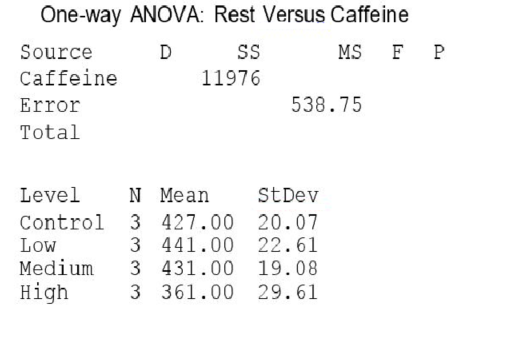Multiple Choice
Investigators gave caffeine to fruit flies to see if it affected their rest. The four treatments were a control, a low caffeine dose of 1 mg/ml of blood, a medium dose of 3 mg/ml of blood, and a higher caffeine dose of 5 mg/ml of blood. Twelve fruit flies were assigned at random to the four treatments, three to each treatment, and the minutes of rest measured over a 24-hour period were recorded. Assume the data that follow are four independent SRSs (one from each of the four populations of caffeine levels) and that the distribution of the yields is Normal.  A partial ANOVA table produced by Minitab follows, along with the means and standard deviation of the yields for the four groups.
A partial ANOVA table produced by Minitab follows, along with the means and standard deviation of the yields for the four groups.  The conclusion that you would draw from this test is:
The conclusion that you would draw from this test is:
A) accept the null hypothesis; all of the groups have the same mean.
B) fail to reject the null hypothesis; there is no evidence to suggest that the groups have different means.
C) reject the null hypothesis; all of the group means are different.
D) reject the null hypothesis; at least one of the groups has a mean that is different.
Correct Answer:

Verified
Correct Answer:
Verified
Q17: Investigators gave caffeine to fruit flies to
Q18: At what age do babies learn to
Q19: A traffic engineer wanted to study the
Q20: A company runs a three-day workshop on
Q21: The one-way ANOVA is a generalization of
Q23: Investigators gave caffeine to fruit flies to
Q24: Which of the following is a true
Q25: Investigators gave caffeine to fruit flies to
Q26: Investigators gave caffeine to fruit flies to
Q27: Many Americans complain about being sleep deprived.